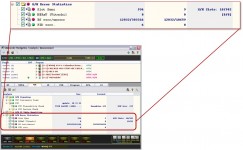ATSC-M/H Signal Error Detection and Correction Algorithms
Introduction
ATSC and ATSC-M/H share the same physical layer (RF) but ATSC is optimized for stationary reception but not for mobile reception. Therefore the ATSC-M/H data portions within the ATSC+ATSC-M/H multiplex are coupled with a chain of extremely high complex error correction mechanisms:
- Viterbi algorithm
- Turbo Codes – SCCC and PCCC
- Reed Solomon algorithm
All these algorithms increase the signal robustness significantly so that mobile reception is possible.
SAMcorder, the central input/output data processor of decontis’ atscSAM analysis and monitoring solution, supports all these error correction algorithms, independent on whether the signal is received via RF, IP, ASI or comes from a captured Transport Stream. Additional optimizations and error corrections have been implemented to maximize reception robustness, which even go beyond the standard specification.
Example
The following short video sequences demonstrate how the M/H signal error correction improves reception. The left video snapshot has been received using a Hauppauge HVR-950 USB stick under poor reception conditions. The right video snapshot shows the identical video after processing lively the ATSC-M/H error correction algorithms on it.
| reception without error corrections | reception with error corrections |
|
|
Analysis and Monitoring
All signal error corrections are analyzed in real-time and the results can be monitored via SNMP.
Slot Sync
– detection of M/H slot synchronization errors
BERaV (Viterbi)
– Bit Error Ratio after Viterbi
RS corr/uncorr
– number of bytes which could be corrected as well as not corrected by the Reed Solomon algorithm
PID corr
– number of wrong detected M/H PIDs which have been corrected







